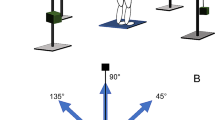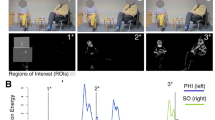Abstract
The listening of biologically significant sound information leads to involuntary postural preparation for the subsequent motor response. In this work, postural indices characterizing changes in the human vertical posture in response to single short biologically significant sound stimuli are investigated. In the first part of the work, a psychoacoustic experiment was performed using the International Affective Picture System in group of 46 subjects. According to its results, three sound stimuli with the duration of about 1 second were selected: two with negative content (a woman’s scream and the sound of a car brake) and one with emotionally neutral stimulus—a phone bell. In the second part of the work, the center of the pressure (CoP) of the body was recorded in response to the three stimuli in a group of 21 subjects. Analysis of the data within 8 seconds after the start of the stimulus (the time of the postural response) revealed a increase in the following stabilometric indices compared to silence: the CoP trajectory length, CoP average linear velocity and the spread along the frontal and sagittal axes, the area of the confidence ellipse. This method proved to be resistant to the variability of latency and amplitude of the postural response. According to the results obtained, short sounds that were with duration less than ones of the postural response, led to a short-term slight destabilization of the pose regardless of their emotional content. The area of the confidence ellipse has the largest changes in comparison with the other indices up to 36–39% according to the average data for different stimuli.





Similar content being viewed by others
REFERENCES
Soames RW, Raper SA (1992) The influence of moving auditory fields on postural sway behaviour in man. Eur J Appl Physiol 65: 241–245. https://doi.org/10.1007/BF00705088
Zhong X, Yost WA (2013) Relationship between postural stability and spatial hearing. J Am Acad Audiol 24: 782–788. https://doi.org/10.3766/jaaa.24.9.3
Gandemer L, Parseihian G, Kronland-Martinet R, Bourdin C (2014) The influence of horizontally rotating sound on standing balance. Exp Brain Res 232: 3813–3820. https://doi.org/10.1007/s00221-014-4066-y
Siedlecka B, Sobera M, Sikora A, Drzewowska I (2015) The influence of sounds on posture control. Acta Bioeng Biomech 17: 95–102. https://doi.org/10.5277/ABB-00150-2014-03
Agaeva MY, Al’tman YA, Kirillova IY (2006) Effects of a sound source moving in a vertical plane on postural responses in humans. Neurosci Behav Physiol 36: 773–780. https://doi.org/10.1007/s11055-006-0087-8
Chen X, Qu X (2016) Influence of affective auditory stimuli on balance control during static stance. Ergonomics 60: 404–409. https://doi.org/10.1080/00140139.2016.1182649
Lelard T, Stins J, Mouras H (2019) Postural responses to emotional visual stimuli Neurophysiol Clin 49: 109–114. https://doi.org/10.1016/j.neucli.2019.01.005
Azevedo TM, Volchan E, Imbiriba LA, Rodrigues EC, Oliveira JM, Oliveira LF, Lutterbach LG, Vargas CD (2005) A freezing-like posture to pictures of mutilation. Psychophysiol 42: 255–260. https://doi.org/10.1111/j.1469-8986.2005.00287
Stins JF, Beek PJ (2007) Effects of affective picture viewing on postural control. BMC Neurosci 8: 83. https://doi.org/10.1186/1471-2202-8-83
Eerland A, Guadalupe TM, Franken IH, Zwaan RA (2012) Posture as index for approach-avoidance behavior. PLoS One 7: e31291. https://doi.org/10.1371/journal.pone.0031291
Lelard T, Krystkowiak P, Montalan B, Longin E, Bucchioni G, Ahmaidi S, Godefroy O, Mouras H (2014) Influence of postural threat on postural responses to aversive visual stimuli. Behav Brain Res 266: 137–145. https://doi.org/10.1016/j.bbr.2014.02.051
Lang PJ (1980) Behavioral treatment and bio-behavioral assessment: Computer applications. In: Sidowski JB, Johnson JH, Williams TA (eds) Technology in mental health care delivery. Ablex Publishing, New York; USA, pp 119–137.
Bradley M, Lang P (2007) The International Affective Picture System (IAPS) in the study of emotion and attention. In: Coan JA, Allen JJB (Eds) Handbook of Emotion Elicitation and Assessment; Series in Affective Science. Oxford Univer Press, New York; USA, pp 29–46.
Yang W, Makita K, Nakao T, Kanayama N, Machizawa MG, Sasaoka T, Sugata A, Kobayashi R, Hiramoto R, Yamawaki S, Iwanaga M, Miyatani M (2018) Affective auditory stimulus database: An expanded version of the International Affective Digitized Sounds (IADS-E). Behav Res Methods 50: 1415–1429. https://doi.org/10.3758/s13428-018-1027-6
Keith RW (2000) Development and standardization of SCAN-C test for auditory processing disorders in children. J Am Acad Audiol 11: 438–445.
Babanov ND, Kalenova AA, Serchenko YaA, Grohovskij SS, Kubryak OV (2019) Standartizaciya, vzaimozamenyaemost i analiz predlozhenij stabiloplatform v Rossii. Probl standartizacii v zdravoohran 9: 10–17. https://doi.org/10.26347/1607-2502201909-10010-017
Rukovodstvo pol’zovatelya “Stabilan-01”. Programmno-metodicheskoe obespechenie komp’yuternogo stabilometricheskogo kompleksa StabMed 2 (2004) Taganrog ZAO OKB Ritm 2004. (In Russ).
Timofeeva OP, Andreeva IG (2021) Postural control features of field-dependent and field-independent subjects in the absence of visual and audio information. Human Physiol 47: 374–381. https://doi.org/10.1134/S0362119721040150
Andreeva IG, Gvozdeva AP, Bobrova EV, Gerasimenko YP (2018) Differences in the postural responses to approaching and receding sound images in subjects with different perceptual styles. Dokl Biol Nauk 482: 6178–6181. https://doi.org/10.1134/S0012496618050125
Timofeeva OP, Gvozdeva AP, Bobrova EV, Andreeva IG (2020) Postural fluctuations in people with different cognitive styles when waiting for auditory information about movement. J Higher Nerv Activity IP Pavlova 70(6): 752–762 https://doi.org/10.31857/S0044467720060106
Mainenti MRM, De Oliveira LF, De Melo Tavares De Lima M, Nadal J (2007) Stabilometric signal analysis in tests with sound stimuli. Exp Brain Res 181(2): 229–236. https://doi.org/ 10.1007/s00221-007-0921-4
Nonnekes J, Carpenter MG, Inglis JT, Duysens J, Weerdesteyn V (2015) What startles tell us about control of posture and gait. Neurosci Biobehav Rev 53: 131–138. https://doi.org/10.1016/j.neubiorev.2015.04.002
Radionova EA (1971) Functional characteristics of cochlear nuclei neurons and auditory function. Nauka, L. (In Russ).
Stevens MN, Barbour DL, Gronski MP, Hullar TE (2016) Auditory contributions to maintaining balance. J Vestib Res 26: 433–438. https://doi.org/10.3233/VES-160599
Lubetzky AV, Gospodarek M, Arie L, Kelly J, Roginska A, Cosetti M (2020) Auditory Input and Postural Control in Adults: A Narrative Review. JAMA Otolaryngol Head Neck Surg 146: 480–487. https://doi.org/10.1001/jamaoto.2020.0032
Timofeeva OP, Andreeva IG, Gvozdeva AP (2021) Dynamics of Postural Indices in Case of Listening to Sounds of Steps Approaching from the Front and from Behind. J Evol Biochem Physiol 57: 1522–1532. https://doi.org/10.1134/S0022093021060284
ACKNOWLEDGMENTS
The authors would like to express their gratitude to the staff of the Laboratory of Movement Physiology of the I.P. Pavlov Institute of Physiology. I.P. Pavlov Institute of Physiology for the given possibility to perform the work on the stabilograph “Stabilan 01”.
Funding
The work was supported by funds from the state budget under the state assignment (project no. 075-0152-22-00).
Author information
Authors and Affiliations
Contributions
Idea of work and planning of the experiment—I.G.A., O.P.T., data collection—O.P.T., data processing—O.P.T., writing and editing the article—I.G.A., O.P.T.
Corresponding author
Ethics declarations
CONFLICT OF INTEREST
The authors declare no apparent or potential conflicts of interest related to the publication of this article.
Additional information
Translated by A. Dyomina
Russian Text © The Author(s), 2022, published in Rossiiskii Fiziologicheskii Zhurnal imeni I.M. Sechenova, 2022, Vol. 108, No. 8, pp. 1042–1057https://doi.org/10.31857/S0869813922080088.
Rights and permissions
About this article
Cite this article
Timofeeva, O.P., Andreeva, I.G. Human Postural Responses to Single Sound Signals with Different Emotional Content. J Evol Biochem Phys 58, 1262–1274 (2022). https://doi.org/10.1134/S0022093022040287
Received:
Revised:
Accepted:
Published:
Issue Date:
DOI: https://doi.org/10.1134/S0022093022040287




